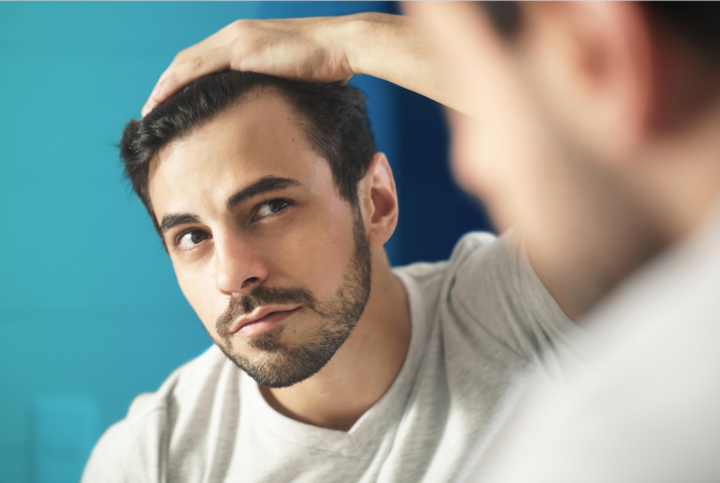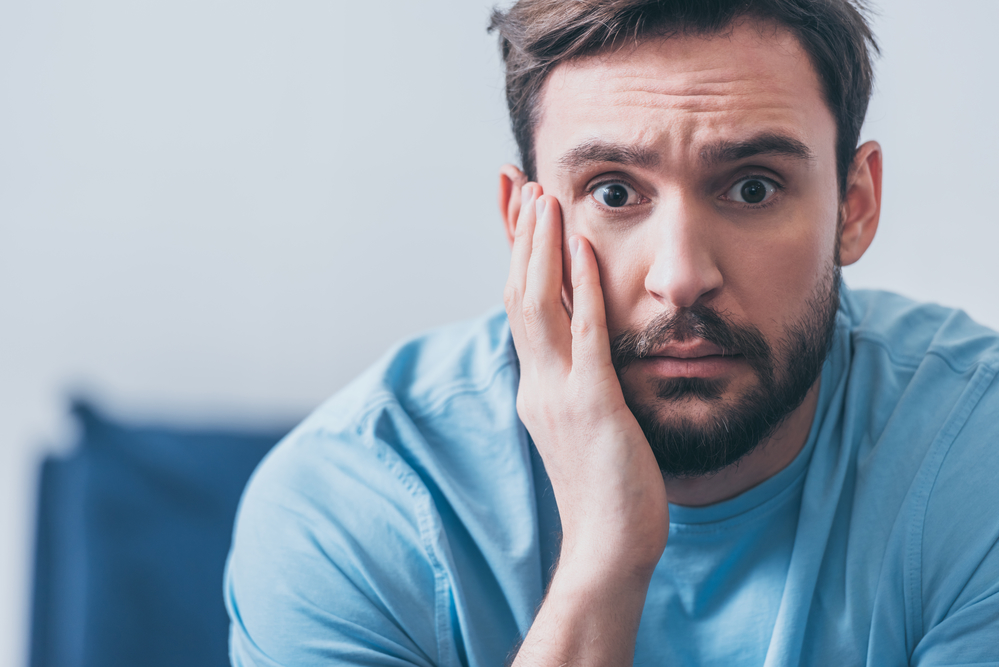Finasteride is a medication used in the treatment of an enlarged prostate and male pattern baldness (hair loss). It contains the active ingredient finasteride and is commonly found under the branded name Propecia. Taken once a day, it can stop further hair loss and thinning and promote hair growth.
Keep reading to find out what finasteride is, how it works, and what you should know before taking finasteride.
What is Finasteride?
The active ingredient in finasteride is finasteride, but you can also find the medication under branded names. Finasteride works best in men who have mild to moderate hair loss. You cannot use finasteride tablets if you have complete hair loss, as it cannot grow back lost hair.
As a hair loss treatment, finasteride is only available privately. It is best to use finasteride long-term to get the best effects for hair loss. Most men see an improvement in their hair within 3 to 6 months of treatment.

Uses of Finasteride
Finasteride is an oral tablet that can be prescribed for two conditions:
- Benign prostatic hyperplasia, which is an enlarged prostate.
- Male pattern baldness, also known as male pattern hair loss, androgenetic alopecia, or androgenic alopecia.
Finasteride is a prescription-only medication, which means it needs to be prescribed to you for either of these conditions.
Benefits of Finasteride
Finasteride has many benefits, depending on which condition you are treating. In men with benign prostatic hyperplasia, you can expect to benefits such as:
● Finding it easier to urinate
● Not feeling like you need to urinate as often or as urgently
● Not having to wake up in the night to urinate
If you are taking finasteride for male pattern hair loss, you can expect to see benefits such as:
● A reduction in hair loss
● Less hair thinning
● Improved hair growth
How Does Finasteride Work?
Male pattern hair loss is thought to be caused by genetics and a hormone called dihydrotestosterone, or DHT. The DHT hormone contributes to both hair thinning and total hair loss. If you overproduce DHT, you will start to notice hair loss symptoms. You can visit your doctor to get a diagnosis of male pattern baldness, which usually starts with thinning at the crown of the head.
When finasteride is taken every day, it lowers DHT levels in the scalp. It does this by blocking a specific enzyme called Type II 5-alpha reductase. Without Type II 5-alpha reductase, your body cannot convert testosterone into DHT. This means finasteride can slow down the progression of hair loss and hair thinning.
In most men, finasteride can also promote new hair growth. It cannot reverse hair loss that has already occurred. Finasteride can only stop hair loss whilst you are taking it.
Dosage and Administration
The recommended dose of finasteride for male pattern hair loss is one tablet daily. Each tablet contains 1mg of finasteride. Whether you take finasteride as an unbranded tablet or a branded treatment like Propecia, the dose will remain the same.
You can take finasteride for as long as you need it. Finasteride is safe to use as a long-term treatment. When you stop taking finasteride, you will notice that your hair loss returns to normal within six months of stopping the treatment.
Finasteride works best when you take it at the same time every day. You should swallow your finasteride tablet whole, with some water. Do not break or crush your tablet. You can take your medication with or without food.
Only ever take the dosage of finasteride that has been prescribed to you.
Side Effects of Finasteride
Finasteride can cause some side effects, but not every person who uses the medication will get them. Most side effects are mild and will only last a few weeks while your body gets used to taking a new medicine.
Common Side Effects
Finasteride does not have any common side effects listed. However, patients have reported some side effects, but the frequency is not yet known. When taking finasteride for hair loss, look out for symptoms such as:
● Anxiety
● Pain in your testicles
● Mild allergic reactions that causes a rash or itchy skin
● Breast pain or swelling
● Blood in your semen
● An increased heart rate
● An elevated level of liver enzymes, which will come up in a blood test
● Difficulty conceiving, which may be caused by poor-quality semen
● Ejaculation disorder (problems with ejaculating)
● A persistent decrease in sex drive
There are also a few uncommon side effects of finasteride. These side effects may affect up to one in every 100 men who take the treatment. Uncommon side effects include:
● Problems getting an erection or ejaculating, such as less semen released during ejaculation
● Decreased sex drive
● Depression
If you notice these symptoms, speak to the healthcare professional who prescribed your treatment, call 111, or visit your GP. These side effects may pass, but some could be a sign of a more serious side effect.
Serious Side Effects
You should not take any more finasteride and get medical help immediately if you notice signs of a serious allergic reaction (anaphylaxis). Symptoms of anaphylaxis include:
● Swelling in the face, mouth, and throat
● Hives, which are lumps under the skin which may be red, itchy, or irritated
● Difficulty breathing
● Fainting
● Dizziness
● Difficulty swallowing
You should also report any changes in your breast tissue to your doctor straight away, as this could be a symptom of a more serious condition like breast cancer. This includes swelling, lumps, pain, or nipple discharge. Your doctor may discontinue treatment if this happens.

Warnings and Precautions
You should always talk to your doctor or pharmacist before taking finasteride for the first time. They will make sure you have no allergies to the ingredients and that any medications you currently take will not interact with finasteride.
Women should not take finasteride, even if they have hair loss. Finasteride only works on men due to the specific hormone it targets (DHT).
Finasteride is not recommended if you and your partner are trying to get pregnant. Finasteride can cause abnormalities in an unborn male baby. Women trying to get pregnant should avoid touching finasteride tablets and should never touch a broken or crushed tablet.
Finasteride can interact and affect the results of a blood exam called a prostate-specific antigen (PSA) test. This is a screening test for prostate cancer. If you are taking finasteride and are having a PSA test, you must tell your doctor or the healthcare professional carrying out the test that you are taking it. Finasteride lowers your PSA levels, which could cause a false result.
The medicine can also increase the risk of irregular or faster-growing prostate cancer. If you have prostate cancer or are being tested for it, you should not take finasteride.
Finasteride should not be used in children or men under the age of 18.
People with liver disease can take finasteride but may need a lower dose to reduce the risk of side effects.
Allergy Warning
You should not take finasteride if you’ve previously had an allergic reaction to any ingredient in the medication. You can check the list of ingredients in the patient information leaflet or ask your doctor. If you notice any signs of an allergic reaction, talk to your doctor straight away. If you have a serious allergic reaction, call 999 immediately.
If you are intolerant to sugars, let your doctor or pharmacist know before taking finasteride.
Drug Interactions
Talk to your doctor if you take any other medications before taking finasteride. Some of your doses may need to be altered whilst taking finasteride, or you may need to take a lower dose of finasteride.
Also, let your doctor know if you take herbal supplements or remedies. Supplements like St John’s wort (used for depression) may affect how well finasteride works for you.
Storage and Disposal
Finasteride can be stored in a locked cupboard or drawer, away from pets or children. It does not need to be stored under any special conditions.
Do not use finasteride tablets after their expiration date. The expiry date always refers to the last day of the month.
You should refrain from throwing away finasteride in your regular household waste. Speak to a pharmacist if you have finasteride tablets that are expired or that you don’t need.
Overdose
Finasteride does not work any better by increasing the dose. Doing so may make you more at risk of side effects, especially serious ones. If you take more finasteride than prescribed, speak to a doctor immediately.
You should never take a double dose, even if you missed a dose the day before. As soon as you remember to retake your finasteride tablets, continue your treatment as normal.
History
Finasteride 5mg tablets were first approved in 1992 for the treatment of benign prostate hyperplasia. Further research found that finasteride also had a second usage: it was preventing and improving male pattern hair loss.
In 1997, finasteride 1mg tablets were approved as a male pattern hair loss treatment. Other medications soon followed, such as dutasteride.
Generic Names
Finasteride is a generic name for the medication, which means the generic drug name. You can usually get an unbranded version of a medication for less cost than a branded version. No matter what name finasteride is under, the treatment, dosage, and way it works are all the same.
Not all doctors or pharmacies will stock the unbranded version.
Brand Names
Finasteride is also sold under the branded name Propecia, which is for male pattern hair loss. You can find finasteride under the branded name Proscar too, but this is for treating benign prostatic hyperplasia.
Research
There has been plenty of research into the results of using finasteride for male pattern hair loss. One such study was carried out when finasteride was first approved for hair loss and was published in 1999. This study concluded that oral finasteride tablets promote scalp hair growth and prevent further hair loss in a significant portion of men.
Further research was carried out in the 2000s, with this study published in 2003. During a 5-year period, daily finasteride was found to maintain or visibly improve the look of hair for 90% of men.
There are ongoing clinical trials to discover whether finasteride can treat other conditions, such as female acne.
Finasteride is also sold as a topical treatment applied directly to the scalp. Clinical trials have found this to be another effective treatment but with more risk of side effects on the scalp, such as itching, irritation, and burning.
Conclusion
Finasteride is an effective treatment for men experiencing male pattern hair loss who want to reduce signs and symptoms. Taken once a day, finasteride can promote hair growth, slow down hair loss, and stop hair thinning associated with male pattern baldness.
You can get finasteride privately by visiting a hair loss clinic or using an online hair loss service.
While we've ensured that everything you read on the Health Centre is medically reviewed and approved, information presented here is not intended to be a substitute for professional medical advice, diagnosis, or treatment. It should never be relied upon for specific medical advice. If you have any questions or concerns, please talk to your doctor.




